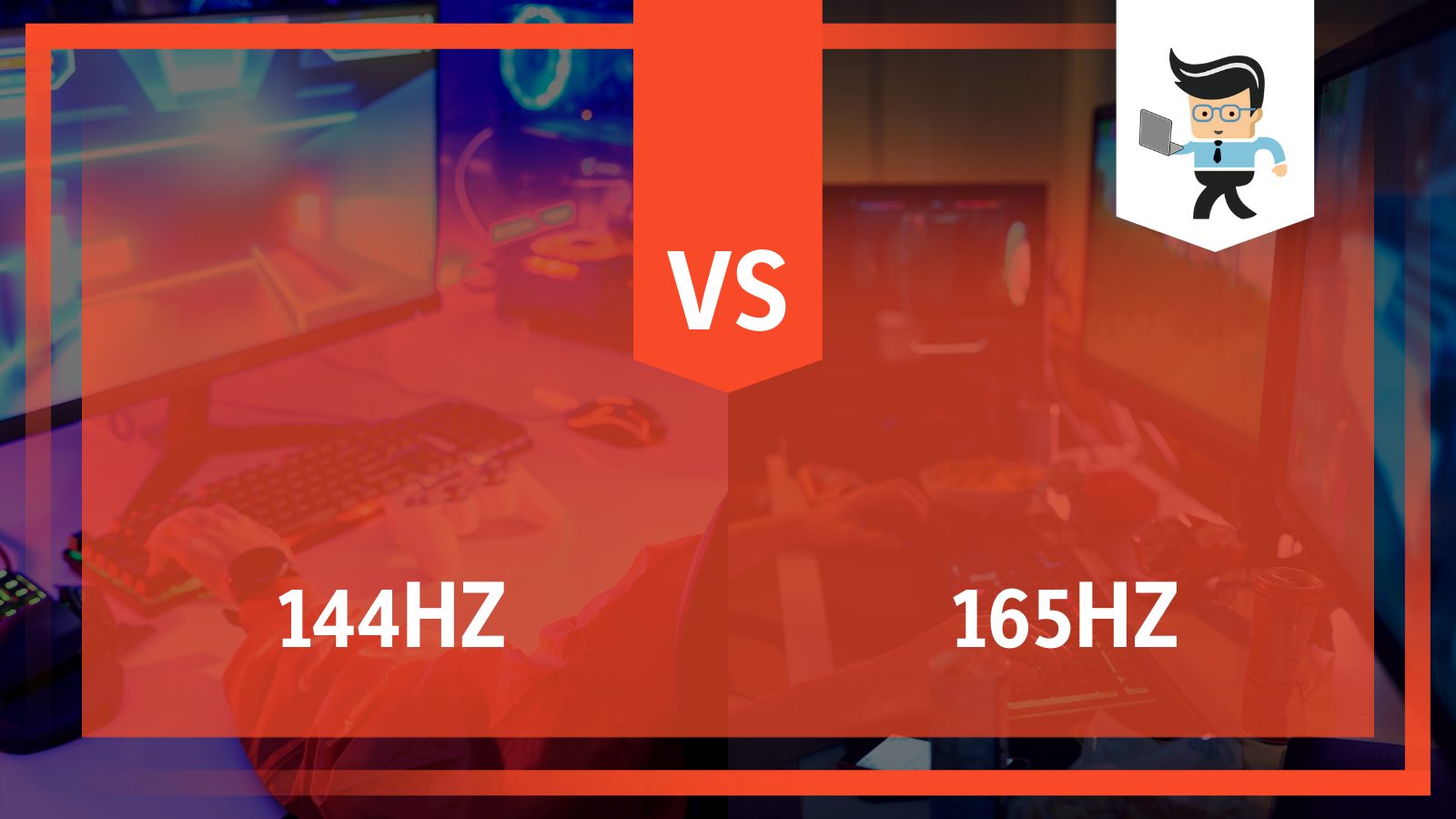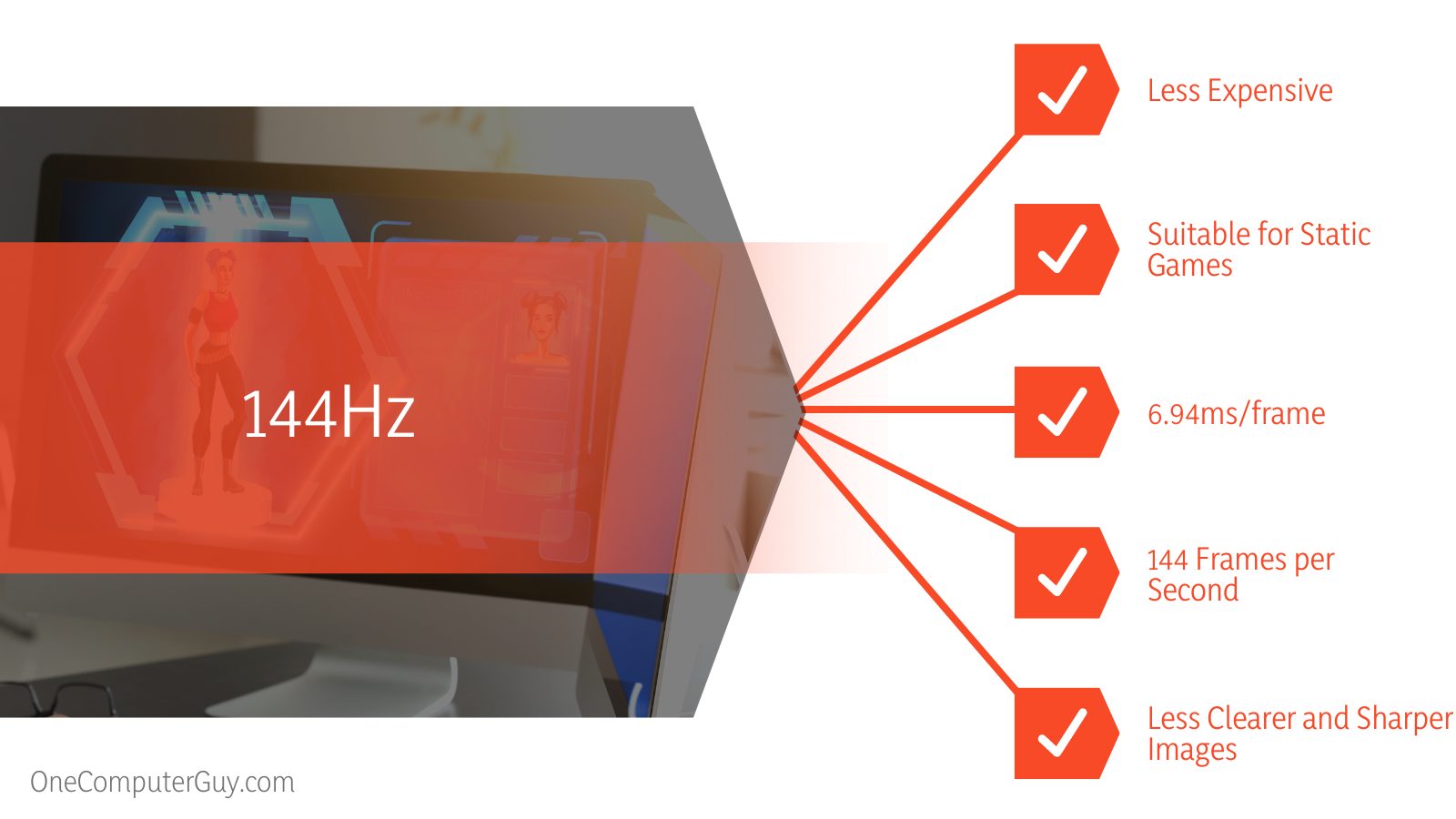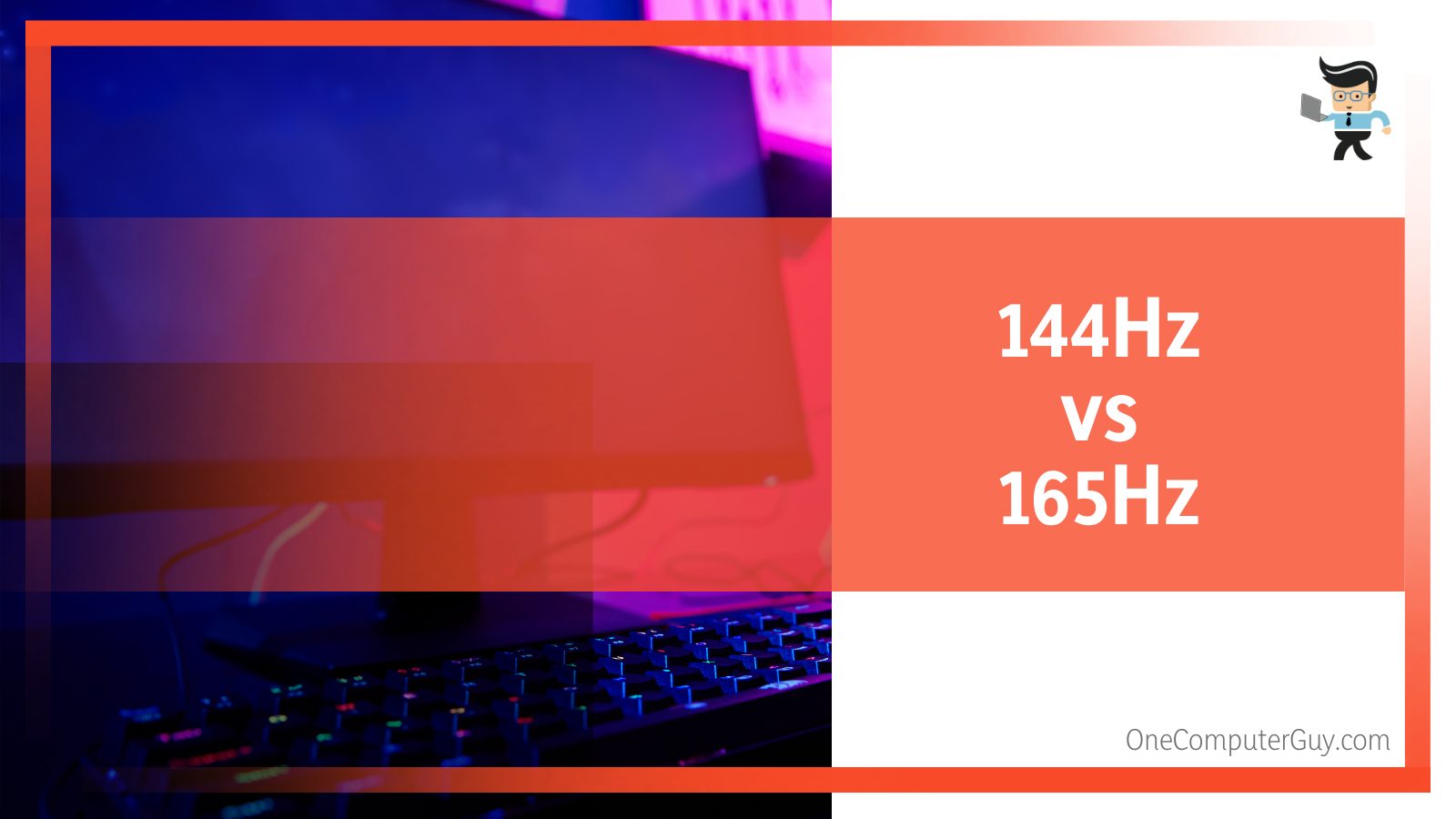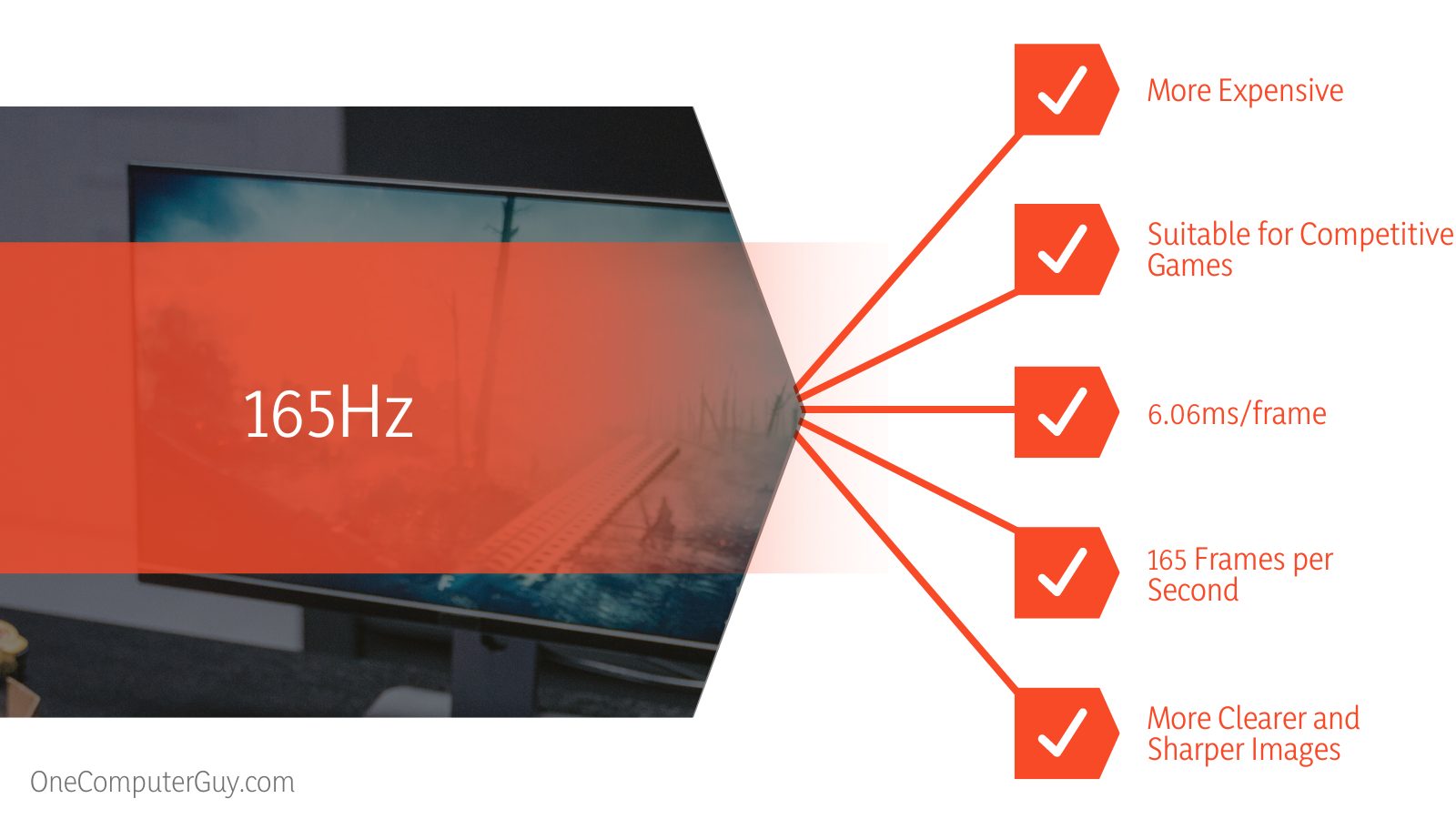144Hz vs 165Hz is a hot debate among serious gamers, and understandably so. If you’re also unsure which refresh rate is the better option for you, don’t worry — our experts are here to help you out!
 Both rates have their own benefits, drawbacks, and uses, which we’ll present in this guide so that you can make a more informed choice when buying your next gaming monitor. Let’s have a more detailed look into the differences so that you understand how the refresh rate affects your overall experience.
Both rates have their own benefits, drawbacks, and uses, which we’ll present in this guide so that you can make a more informed choice when buying your next gaming monitor. Let’s have a more detailed look into the differences so that you understand how the refresh rate affects your overall experience.
Contents
144Hz vs 165Hz Comparison Table
| Features | 144Hz | 165Hz |
| Number of frames per second | 144 | 165 |
| Time taken to display a frame | 6.94ms/frame | 6.06ms/frame |
| Cost | Less expensive | More expensive |
| Suitable for | Static games | Competitive games |
What Are the Differences Between 144Hz and 165Hz?
– Animation and Image Quality
The difference in the number of frames leads to many other differences, and we’ll discuss each of them in detail. The very first difference lies in the animation and image quality. Both refresh rates ensure a smooth and good gaming session based on the games you opt for. However, when it comes to the overall performance, especially if you like to play demanding titles like FarCry 6 or CyberPunk 2077, 165 Hz is the definite winner.
With 165 Hz, you get to enjoy clearer and sharper images, smoother transitions, and stronger colors. Plus, you’re able to see details that you never noticed before. In contrast, it’s impossible for a 144 Hz refresh rate to provide the same benefits because of the number of frames.
A high refresh rate also means you get higher image resolution, which, in turn, minimizes overall stuttering, screen tearing, and motion blurring, which can have a big impact on your performance, especially when it comes to competitive games. That’s not to say that 144Hz is all bad. You can still enjoy smooth gameplay, but for static games that are not as demanding or intensive as immersive RPGs or horror games.
– Number of Frames per Second
This difference is pretty obvious – with 144Hz, you get 144 frames per second, while with 165 Hz, you get 165 frames per second. This means you get 21 more frames per second with the latter, which brings about a number of more benefits. In particular, it shapes up your whole gaming experience by reducing motion blurring, ghosting, and screen tearing.
As mentioned above, the high frame rate is really important when it comes to competitive games, since you’re able to notice every transition and every move without experiencing any screen tearing. And it makes sense – when your screen is refreshed 165 times, it can display the visuals with more details and better clarity compared to 144 Hz.
 – Cost
– Cost
As you might expect, the better performance and quality of 165 Hz come at a greater price, which means you can expect more expensive gaming monitors. But the real question is, are more expensive 165 Hz monitors worth the price? The answer comes down to how seriously you take gaming.
If you think you’re very passionate about gaming and are a competitive gamer who loves playing demanding and high-quality, dynamic video games, you should definitely upgrade to a better (but more costly) monitor. However, there are many video games that you can enjoy on a 144 Hz gaming monitor, particularly if your GPU cannot handle upgrading to 165Hz.
Keeping these things in mind, it’s clear that the choice of whether you should spend more and enjoy 165Hz or just stick to 144Hz depends on your GPU and your gaming preferences.
– Response Time
The response rate is related to the number of images the gaming monitors can display per second. Apart from how smoothly and quickly your character moves, the response rate also depends on the refresh rate.
Shorter response rates translate to more fluid controls and get rid of visual artifacts that can negatively affect your performance overall.
– FPS
FPS or frames per second is the number of frames that the monitor can render per second. Keep in mind that this is different from the refresh rate, which is basically the maximum number of frames that the monitor is able to display each second.
To get the best experience, you should have the smallest gap possible between the refresh rate and fps. This is because a bigger difference can ultimately cause screen tearing. So for instance, if you have a 60 fps monitor, it won’t be able to completely handle your upgrade to a 144Hz monitor as it will fail to render and display the number of frames. And if it can’t handle 144Hz, 165Hz is an entirely different story.
So before you go ahead and purchase a 165 Hz refresh rate monitor, make sure you familiarize yourself with the system and are well aware of its capabilities.
– Competitive Gaming
There’s no doubt that 165Hz is the clear winner for competitive games. It is a much more reliable option than 144Hz, particularly because the difference in quality is greatly emphasized in such games. Of course, there are even better options when it comes to competitive gameplay, but 165Hz is good enough, particularly for a dynamic multiplayer environment.
With 165Hz, you get quicker transitions, vivid colors, and smoother gameplay. Along with that, you experience fewer visual issues like stuttering, ghosting, and tearing.
– Overall Gaming Experience
The 21Hz jump from 144Hz to 165Hz isn’t much and reduces the display time by just 0.88ms/frame. This time will reduce as the proportional increase in the Hertz goes lower and the refresh rate increases. As a result, it’s very difficult to spot the differences between high frame rates.
However, even with the 14.5 percent increase in frame rates, you will notice some improvement in the overall gaming performance. The additional FPS will make camera panning and movement much smoother, reduce or completely eliminate x-axis blur, make controls more fluid, and make the game feel and look incredibly immersive.
 – Titles You Can Play
– Titles You Can Play
For most online multiplayer games, a 144 Hz refresh rate can easily display the full environment of the game without you having to sacrifice a lot. This is because most online multiplayer games have lighter graphics development in comparison to solo RPGs that feature dynamic and rich environments.
Of course, you can still use 144 Hz monitors for AAA titles like the new Fallout games or The Witcher 3, and you’ll notice quite a difference if you play on a 144 Hz monitor instead of a 60 Hz one. For instance, if you have the MSI Prestige PS-1WU and you switch to a 144Hz Asus ROG or an Acer Predator monitor, you’ll notice a great difference.
However, you’ll start to notice issues when you try to pan your view. You’ll also notice some delays when the game tries to render the borders of the screen when you turn. Meanwhile, 165Hz can easily handle rendering rich and complex 3D environments without a problem. It is as high as avid mainstream gamers go, while professional gamers and PC enthusiasts opt for a higher refresh rate, both for aesthetic and competitive advantages.
The good thing about 165Hz is that you can play all games; the higher refresh rate eliminates the risk of slow rendering or blurry images in virtually all games currently present on the market. Of course, both your build and CPU affect the visual output, but the main players are the refresh rate and GPU.
– Overclock
Overclocking your monitor, regardless of the refresh rate, can help take things up a notch, and you can get in a few more Hz. For instance, it’s possible to take some 144 Hz monitors to 165 by overclocking them. And since the image will be refreshed more times each second, you can get a better experience when playing games like COD.
Most monitors will allow you to go up at least 10-20 Hz, and above that, it all comes down to your luck. So for instance, if you have a 150Hz monitor from the Viewsonic Elite XG series, you can take it up to 165Hz. But you should keep in mind that TN panels tend to overclock relatively better than VA or IPS panels.
What Is 144Hz Best For?
A 144Hz refresh rate is best for static games that don’t have a lot of dynamic scenes or even a rich environment. It is also the best option for you if you’re on a budget, since 165 Hz costs considerably more than 144 Hz.
Plus, most habitual gamers find that they don’t need to upgrade to 165 since 144 can handle rendering their favorite games.
So if you don’t really play visually demanding games, a 144 Hz monitor should be enough for you. However, it’s not the best option if you play higher fps games that rely on a higher response time.
What Is 165Hz Best For?
A 165 Hz monitor like the Dell S-22DGM is the best option for high-quality and demanding games, since it reduces overall motion blur and ensures smoother gameplay. As the refresh rate increases, so does the fps in competitive games, which reduces input lag and makes it possible for you to take prompt action, particularly in multiplayer games.

Apart from competitive games, 165Hz is also the better option for 4K gaming. However, before you make the upgrade, make sure your GPU can actually support it. You should also keep in mind that 165Hz is more on the higher end of the price spectrum, so it’s not the best option for you if you’re on a budget.
With that said, it’s important to mention that 165Hz is also the better option for games with numerous details, such as immersive RPGs. It offers improved HDR, better panels, faster response, vivid colors, and sharper images.
FAQs
– Is 165Hz Enough for Gaming?
Yes, 165Hz is good enough for gaming, and while many serious gamers have switched to 165Hz, you need to keep the cost in mind. If you currently use a good-enough 144 Hz monitor, then switching to 165 just for 21 more frames isn’t really worth it.
However, if you’re already in the market and have to choose between 144 and 165, then you should definitely go for the latter, especially if you’re upgrading from a 60Hz monitor. You can also try out both of these monitors to see which one you prefer before shelling out your hard-earned cash.
– What Is the Best Hz for Gaming?
A minimum of 75Hz along with the lowest response rate you can get is the best for gaming. As a rule of thumb, you need to remember that when it comes to gaming, higher refresh rates are always better.
Most gaming monitors are at least 144Hz, which is good enough for competitive gameplay and is definitely worth the price. Apart from a more responsive and enjoyable experience, you have a great advantage over your enemies who use 60Hz displays, giving you a chance to beat them easily!
There’s no doubt that 240Hz is great for fast-paced games, especially since it makes them incredibly fluid and smooth. However, many 144Hz vs 240Hz debates prove that the jump from 144 to 240 isn’t very noticeable compared to the differences you notice when making the jump from 60 to 144Hz.
Similarly, while 165 is better than 144, switching might not be worth the cost unless you’re a serious or professional gamer. Jumping up even higher to 240Hz will guarantee even more dramatic improvements, but, again, you need to consider the cost.
Conclusion
As you have seen by now in our 144Hz vs 165Hz review, the two rates have a number of differences. The main difference is that 165Hz offers you 21 more frames each second, which brings about various benefits. For instance, you get better animation and image quality, more fps, a better response rate, and an overall better experience.
However, 165Hz is more expensive. This is why you should do a 165Hz vs 144Hz test to see if you really want to spend the extra amount. With that being said, we do recommend not to switch from 144Hz to 165Hz since the difference isn’t too much unless you’re a professional gamer. But if you’re changing your 60Hz monitor, then you can go ahead and try out both to see which one you like better!







